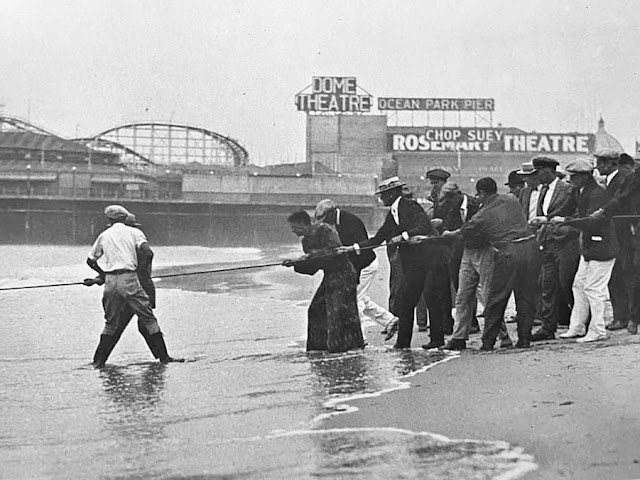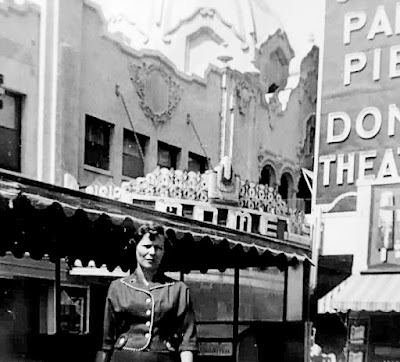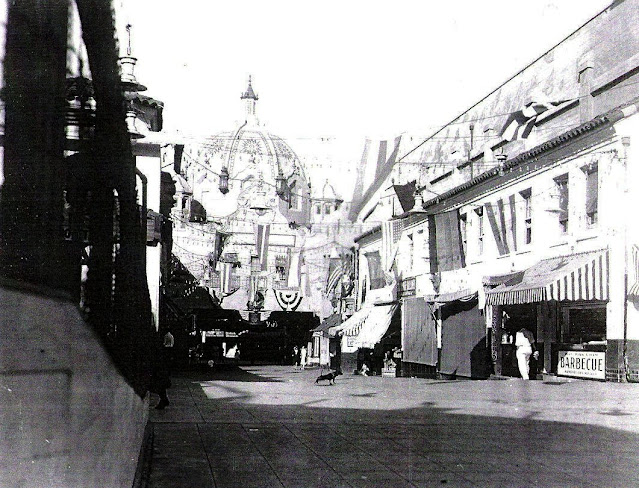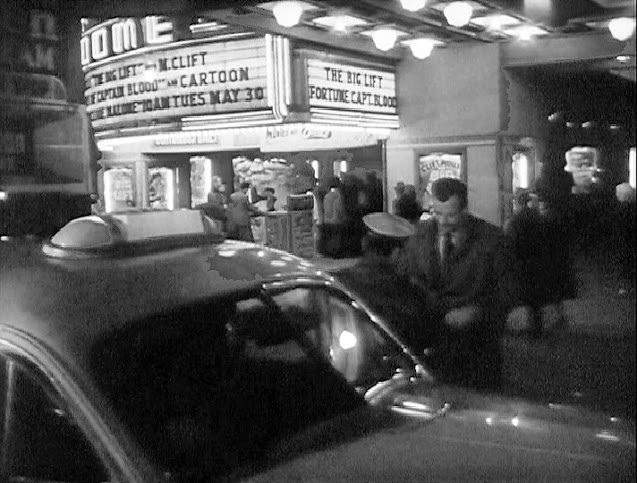Opened: June 1924. It was on the west side of the Promenade just north of
Marine St. The entrance to the Ocean Park Pier was via a lovely dome just north of the theatre. This 1938 photo from the MGM art department is now in the Los Angeles Public Library collection.
The address was listed as 3004 Ocean Front Promenade in the 1925 and 1927 Santa Monica city
directories. In the 1940 and 1954 city directories it's listed as 3012 Ocean Front
Promenade.
Seating: 2,213
Architect: Clifford A. Balch. Robert Power Studios was the decorator.
A pier fire on January 6, 1924 destroyed the earlier locations of the
Dome and Rosemary theatres along with nearly everything else on the
Lick and Ocean Park piers. See the page about Dome Theatre location #1 for photos of that building before and during the fire.
Venice Investment Co. and West Coast Theatres swooped down after the
fire and within weeks had bought the assets of the Pickering and Lick pier operating
companies. The old Dome location had been part of the Lick pier complex
in Venice. Everything north of that was part of the Pickering empire,
within the Santa Monica city limits. After difficult negotiations with the City of Santa Monica, who asserted that a lease was required, they rebuilt the piers.
Thanks to Joe Vogel for finding a mention in the February 1, 1924 issue of Southwest Builder & Contractor that noted:
"Venice Improvement Company and West Coast Theaters… propose to expend immediately more than $1,000,000 for a 2000 seat theater to replace the Dome Theatre destroyed by the recent conflagration…."
Joe also found an April 4, 1924 mention in the L.A. Times saying:
"Work will be started tomorrow."
But they couldn't wait. A temporary Dome Theatre was constructed in 23 days, opening with the world premiere of "The Perfect Flapper" starring Colleen Moore and Syd Chaplin. This ad for "The Wonder Theatre" appeared on May 29, 1924:
And less than three months after work started on the permanent replacement theatre they were open. Joe Vogel found a mention in the June 30, 1924 issue of the Santa Monica Outlook saying:
In 1929, after William Fox bought enough stock to control West Coast Theatres, the firm operating the theatre became Fox West Coast and it was advertised as the Fox Dome. Fox West Coast also operated the Rosemary. The new Dome Theatre was just north of the original location. The entrance of the original Dome Theatre was reused for the Rosemary Theatre with a new building constructed for the auditorium.
The Dome's place in history is assured as it was the theatre, or one of
several theatres, where the Mickey Mouse Club fad began. At least that's
the story. It was part of a matinee promotion by manager Harry Woodin.
The September 14, 1929 Motion Picture News has a short item about Woodin doing kiddie promotions at the Dome (which they say is in "Oakwood Park") as well as at the California in Venice. Thanks to Mike Hume for locating this item on Internet Archive.
This 1930 flyer appeared on a post about the club on the blog Disney Detail. See Mickey Masks for a discussion of the clubs and a c.1934 photo at an unidentified theatre of an audience with Mouse masks. Disney archivist Elizabeth Spatz comments:
"The Fox Theatre circuit was the main if not exclusive partner in founding and operating the Mickey Mouse Clubs starting with the Fox Dome in Venice, CA in 1929 (not 1930, as often stated) and continued to receive Disney’s operational support through 1933; extant clubs continued to be supported by Disney into the mid 30s but new clubs were not, after 1934/35. Yes, this flyer indicates that the clubs were launched at the Dome in
January of 1930, but we have internal communications between Walt Disney
and Harry Woodin, PR/manager of the Dome, that proves the clubs were
actually started before that time. I believe the poster was created as
an official launch of the club that, after a successful out-of-town
trial held in Salem, OR, was granted support and branding of the Disney
company."
"The Dome closed for good on September 23rd, 1956, a
Sunday. The previous week it had only been open (and advertised that
way) on Friday, Saturday, and closing Sunday. Interestingly, I paid my
farewell visit to the Dome the week before, seeing 'Hot Rod Girl.' My
grandparents lived in the Hotel St. Regis, which was just down the
street and directly across from what a mere year later would be the
entrance to POP. My grandfather had a big roulette stand on the Ocean
Park Pier just past the entrance to the Ocean Park Pier, which was next
to the Dome (and which would become the exit from POP). They began
tearing down that side of the boardwalk almost immediately after the
Dome closed."
Status: The Dome and Rosemary theatres were demolished in the summer of 1969 although other buildings on the piers remained. Glen Norman notes that this round of demolition was done as an attempt by John (Jack) Morehart to jump-start his redevelopment plans for the area. There was a series of arson fires in the ruins between December 1969 and July 1974. Final demolition of what remained was in the winter of 1974-75. Today no traces of the amusement area remain.
Lobby views:
A 1957 lobby view from house left. The area was being used as a workspace for Pacific Ocean Park planners. It's a photo from the Osterhout Family Collection now on the Santa Monica Public Library website. Their caption: "Designers, sculptors, and artisans of various trades busy at work during the construction phase of Pacific Ocean Park.."
The house right end of the lobby in 1957. The stairs to the balcony at the far end are concealed by a drape. It's a photo from the Osterhout Family Collection now on the Santa Monica Public Library website.
The auditorium:
This photo appeared with a "Theatre Decoration and Stage Equipment" article in the February 18, 1928 Motion Picture News.
It was headed "Robert E. Powers [sic] Studios and Armstrong-Powers
Studios Among Leaders in Development of Features for DeLuxe Houses." The Dome was decorated by the Power Studios and presumably had
Armstrong rigging equipment backstage. The firm also did the new Rosemary next door.
A version of the photo above with different cropping that appeared in a trade magazine. Here we get a better look at the side wall treatment. Thanks to the Ronald W. Mahan Collection for sharing it.
A look to the rear of the house. Note the main floor projection booth. The undated photo is in the Los Angeles Public Library collection.
A look toward the stage. Note the Skouras-style "upgrades." It's a 1957 photo from the Osterhout Family Collection on the Santa Monica Public Library website.
The back of the main floor. It's a 1957 photo from the Osterhout Family Collection now on the Santa Monica Public Library website.
The front of the booth gets its closeup. It's a 1957 photo from the Osterhout Family Collection now on the Santa Monica Public Library website.
A view back from the stage of the doomed theatre. It's a 1957 photo from the Osterhout Family Collection now on the Santa Monica Public Library website.
A look across the balcony. It's a 1957 photo from the Osterhout Family Collection now on the Santa Monica Public Library website.
More exterior views:
1924 - On the right, note the signage saying in traditional Orpheum circuit script that the Dome Theatre is the home of Orpheum vaudeville. The sign wasn't actually on the theatre's marquee. The Dome Theatre entrance wasn't under the big dome we see -- that was the entrance to the pier. The theatre entrance is just beyond. On the far left note the vertical for the Rosemary Theatre. It's a photo in the Los Angeles Public Library collection.
c.1925 - A view north on the Promenade. The Rosemary Theatre is in what, before 1924, had been the location of the Dome Theatre. The facade and that barrel vault entrance got reused, the rest was a quickly erected new building. On the far right note the signage for the Palace dance hall. It's a photo in the Santa Monica Public Library collection.
c.1925 - A view from a bit farther north. That's the Lighthouse Slide seen on the right. It's a card that once appeared on eBay.
1925 - A rare postcard looking back at the dome and the Dome Hotel from out on the pier. The Dome Theatre is off to the right. This copy of the card was a find of the late Chrys Atwood for the Venice, Ocean Park and Santa Monica Facebook page. The readerboard copy is advertising the opening of the Light House Slide and Halloween Carnival on Saturday, October 31st.
c.1925 - This lovely postcard view was discovered by Chrys Atwood. It was a find on eBay for a post on the Venice, Ocean Park & Santa Monica Facebook page. On the marquee at the Rosemary they were advertising vaudeville along with the feature picture.
1925 - The Dome's marquee advertising Singer's Midgets and Orpheum Vaudeville. The small oval readerboard is promoting the Halloween Carnival on October 31st. Note the roof sign in the upper left that was positioned to be visible from Marine Ave. It's a card that once appeared on eBay.
1927 - The Rosemary is playing Tod Browning's film "The Unknown," a June release with Lon Chaney. And on the night the photo was taken there was also a sneak preview. It's a photo from the Ernest Marquez collection appearing on the Huntington Library website. A lower resolution version is in the collection of the Santa Monica Public Library where they credit it as taken by Adelbert Bartlett.
1928 - A view north toward the Lick Pier by Adelbert Bartlett in the Huntington Library collection. That strange spire rising behind the "Lick Pier" sign was the Lighthouse Slide.
1929 - A glorious view by Thompson Photo Service of Santa Monica. That's the Shoot the Chutes ride out at the end of the pier, where you could slide down the 130' high incline in a flat-bottomed boat into a 3' deep tank. It was a 1929 addition. This copy of the photo is from the Ernest Marquez collection and appears on the Huntington Library website.
1929 - A detail from the Thompson Photo Service image.
1929 - A Promenade detail taken from the Thompson image. The building in the center with the fanciful domes is the Ocean Park Bathhouse.
c.1930 - A performer up on the roller coaster with a view behind him toward the entrance dome and the Dome Theatre. It's a photo by Adelbert Bartlett in the Santa Monica Public Library collection.
1930 - A view from some unknown archive that once popped up on the Vintage Los Angeles Facebook page but then vanished from that page.
1931 - This 1931 postcard view north on the Promenade was a find of the late Chrys Atwood for a post on the Venice, Ocean Park & Santa Monica Facebook page. The card appears in the page's "Trams Through The Years" set. At the Rosemary it's Joan Crawford and Neil Hamilton in "Laughing Sinners."
c.1932 - A children's floral parade along the Promenade. It's a photo on Calisphere from UCLA's L.A. Times Photographic Archive. The vertical sign on the far left is for the St. Regis Apartments on the northeast corner of Kinney St. and the Promenade.
c.1933 - Looking south on the Promenade. It's a photo by Adelbert Bartlett in the Santa Monica Public Library collection.
c.1934 - A photo from back a bit farther taken by Adelbert Bartlett that's in the Santa Monica Public Library collection.
c.1934 - A photo by Adelbert Bartlett from the Santa Monica Public Library collection.
c.1935 - A lovely photo by William McCarthy that's in the collection of the California State Archives. A comment on the site about the collection:
"Capturing the rich history of the early twentieth century, the William M. McCarthy Photograph Collection highlights well-known landmarks, historic events, and scenic vistas from the Pacific Ocean to the Atlantic, from the Deep South to Canada, and from Mexico to Cuba. Scenes across the Golden State are captured in stunning shots from Lake Tahoe to Yosemite and the Central Coast to Southern California cities. The collection features nearly 3,000 photographs taken by native Californians William M. and Grace McCarthy from approximately 1905 to 1938. The McCarthys traveled extensively during the early years of automobile travel, as newly constructed highways connected people and places throughout the United States and beyond, providing pictorial documentation of a pivotal period in our nation's history..."
c.1937 - A photo by Herman Schultheis that's in the Los Angeles Public Library collection.
c.1937 - A sign detail by Herman Schultheis that's in the Los Angeles Public Library collection.
1940 - Scott Charles has done a lovely job of overlaying a 1940 vintage aerial photo of the Ocean Park piers on top of a current map of the area. The Rosemary and Dome Theatres are just above the word "Ballroom." He discusses his project on Noirish Los Angeles post # 46596. Also see his full image, which also covers the Santa Monica and Venice piers: https://i.imgur.com/0ZApE6Z.gif
c.1940 - An Ansel Adams photo in the Los Angeles Public Library collection.
c.1940 - An Ansel Adams photo in the Los Angeles Public Library collection.
c.1940 - An Ansel Adams photo in the Los Angeles Public Library collection. A note from the Library's website:
"Around 1939, Ansel Adams
was commissioned by Fortune magazine to photograph a series of images
for an article covering the aviation history of the Los Angeles area.
For the project, Adams took 217 photographs showing everyday life,
businesses, street scenes, aerospace employees, and a variety of other
subjects, but when the article, 'City of Angels' appeared in the March
1941 issue, only a few of the images were included. In the early 1960s,
approximately 20 years later, Adams rediscovered all of the photographs
among papers at his home in Carmel, and sent a letter of inquiry to the
Los Angeles Public Library, asking if the institution would be
interested in receiving the collection as a donation.
1942 - A view out the pier taken by Emerson Gaze. That's the side of the theatre over on the left. The photo is in the Bill Beebe collection at the Santa Monica History Museum. It appeared as a post on the SMHM Facebook page.
1944 - The Rosemary is running two April releases: "And the Angels Sing" with Dorothy Lamour, Fred MacMurray and Betty Hutton along with "Henry Aldrich Plays Cupid" with Jimmy Lydon and Charles Smith. It's a photo by Bill Beebe that's in the Santa Monica History Museum collection. Note the lit roof sign in the middle of the image. It was for people walking down Marine St. toward the Promenade.
1940s - A postcard from Frank the Prospector on Flickr. It's one that had popped up on eBay.
1953 - Thanks to Will Markland for this view out on the pier. It was a post on the Vintage Los Angeles Facebook page.
1957 - "This show is not for junior." That's the Dome's stagehouse rising up in the center of the photo. It's a photo in the Herald Examiner collection at the Los Angeles Public Library. Thanks to Maurice Ideses for spotting it in the collection. See the page on the Star Theatre for more about this building.
1957 - The vertical sign getting disassembled as work begins on transforming the pier area into Pacific Ocean Park. The theatre would be gutted for reuse as the Magic Carpet ride. POP opened July 26, 1958. It's a photo in the Santa Monica Public Library collection that was donated to the Library by the Osterhout Family Collection.
1957 - A view looking south. It's a photo from the Osterhout Family Collection appearing on the Santa Monica Public Library website.
1957 - Another photo from the Osterhout Family Collection appearing on the Santa Monica Public Library website.
1957 - A pier view toward the stagehouses of the Dome and Rosemary during the POP construction. It's a photo from the Osterhout Family collection donated to the Santa Monica Public Library.
1958 - The marquee that had been over the pier's entrance is gone. What's left are the marquees for the Dome Theatre and, on the far left, the Rosemary. It's a photo from Pacific News Pictures in the Santa Monica Public Library collection.
1958 - A look along the back of the stagehouse, here with the theatre repurposed as part of Pacific Ocean Park. Thanks to Jeffrey Stanton for the photo, one appearing on his terrific Venice History Site hosted on Westland.net.
1958 - Looking toward the "International Promenade" and the exit under the dome from Pacific Ocean Park. On the right in the foreground it was the Mirror Maze. Just beyond, also on the right, is the side of the Dome Theatre, repurposed as the Magic Carpet ride. The photo appeared on a 2009 Gorillas Don't Blog post titled "Pacific Ocean Park Monday."
1961 - A view toward the exit from the Los Angeles Public Library collection.
1961 - The back of the stagehouse. It's a Los Angeles Public Library photo.
1965 - A photo by Victor Barnaba that he donated to the Santa Monica Public Library.
c.1968 - The building on the left had once been the entrance to the Dome Theatre. It's a photo in the Los Angeles Public Library collection.
1969 - The dome at the head of the pier getting demolished. The Rosemary and Dome Theatres would be next. The theatre entrance was off to the left. It's a photo in the Herald Examiner collection at the Los Angeles Public Library.
1970 - The theatre was demolished in the summer of 1969. Its foundations are seen in the lower left in this view taken the day after the May 27, 1970 Aragon Ballroom fire. It was one in a series of fires in the ruins between late 1969 and the summer of 1974. The photo, from Bill Dahlquist and Don Nash of the Los Angeles Fire Department Historical Society, appears in a 16 photo "Pacific Ocean Park Pier Fire" album on Flickr.
1970 - A look toward land in another May 28 photo from the Los Angeles Fire Department Historical Society "Pacific Ocean Park Pier Fire" album. The big dome over the pier entrance (used as POP's exit) used to be straight down the midway to where it meets the street. The theatres were in the vacant lots to the right of that. Thanks to Glen Norman for his research on establishing the demolition date of the Dome and Rosemary theatres as well as finding these 1970 photos.
1972 - The vacant lots to the left of the pier centerline are the sites of the Rosemary and Dome. It's a photo dated May 19 from the City of Santa Monica that's now in the Santa Monica Public Library collection. Also see a view looking inland toward the end of the pier. The curving street is Barnard Way with the portion on the right before the curve lined up with where Speedway had been. Ocean Front Promenade lined up with the front of the buildings we see remaining in the center of the image.
1972 - A June photo taken by Glen Norman looking south on the Promenade toward the vacant lots where the Dome and Rosemary theatres had been. Thanks, Glen!
1975 - The cleared beach and only a few remnants of the pier left in the water. It's a photo taken by the Santa Monica Police Department that's in the Santa Monica Public Library collection.
2019 - Looking out to where the Dome and Rosemary theatres once were. Behind us it's all condos. There's no more Ocean Park business district unless you go several blocks east to Neilson Way/Pacific Ave. or Main St. Photo: Google Maps
This marquee shot appears in Norman Foster's "Woman on the Run" (Universal-International,1950). Although set in San Francisco, the amusement park sequences at the end were filmed in Ocean Park. The screenshot is from a page on the site Reel SF, where the film's locations are discussed. We also see the Star Theatre during a walk out on the pier. See the Historic L.A. Theatres in Movies post for that shot.
We're on Ocean Front Promenade with Mickey Rooney and Barbara Bates in Irving Pichel's "Quicksand" (United Artists, 1950). We're looking south with the Dome marquee in the foreground and the vertical sign and marquee of the Rosemary visible beyond. The film also features Peter Lorre and, as the femme fatale ruining Mickey's life, Jeanne Cagney.
A view out on the pier from "Quicksand." We're looking east toward the Promenade with the dome over the the pier's entrance seen on the left. On the right it's the side of the Dome Theatre with the stagehouse rising up at the center of the image.
The
Dome on TV:
Thanks to Cezar Del Valle for spotting the Dome in the 1957 Ed Wood pilot "Final Curtain." It's on YouTube. There are many murky interior views in a theatre, but they were shot at the Forum Theatre on Pico Blvd. See the Historic L.A. Theatres In Movies post for two of them.
More Information: See the page on the first Dome Theatre for more about that building, lost to fire in 1924.
And if you'd like to sort out the various Rosemary locations, here are those pages: Rosemary #1: Ocean Front Promenade north of Pier Ave. - c.1910 - 1912 | Rosemary #2: Trolleyway between Kinney and Pier Ave. - 1912 - 1913 | Rosemary #3: 6 Ocean Park Pier - 1913 - c.1919 | Rosemary #4: 2946 Ocean Front Promenade - c.1919 - 1924 | Rosemary #5: 3034 Ocean Front Promenade - 1924 -1969 |
The listings at the bottom of the Theatres Along the Coast survey page have some Ocean Park history references. The site Cinema Treasures has a page on the Dome Theatre.
Thanks to Jeffrey Stanton for his research, much of it appearing on the terrific Venice History Site hosted on Westland.net. See his articles about the "Fraser / Pickering / Lick Piers 1913-1924," "Ocean Park Pier 1926-1956," "Amusement Pier Fires" and "Movie Making in Venice and Ocean Park." Mr. Stanton is the author of "Venice California - Coney Island of the Pacific," available direct by check or money order for $59.57, including tax. He's at 12525 Allin St. Los Angeles 90066. His email: jeffreystanton@yahoo.com.
| back to top | Theatres Along the Coast | Along the Coast - list by address | Downtown theatres | Westside theatres | Hollywood | Westwood and Brentwood | [more] Los Angeles movie palaces | Los Angeles theatres - the main alphabetical list | Los Angeles theatres - list by address | theatre history resources | film and theatre tech resources | contact info | welcome and site navigation guide |


















































































No comments:
Post a Comment